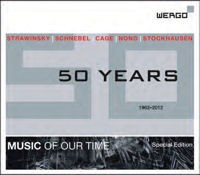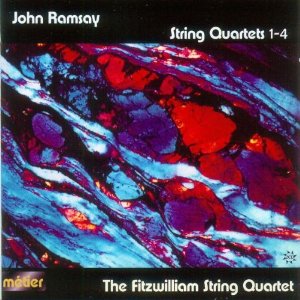|
You are reading the older HTML site
Positive Feedback ISSUE 62
Notes of an Amateur: Music of Our Time from Wergo.
Johm Ramsay's String Quartets.
Music of Our Time: 50 Years. Since 1962. Stravinsky, Schnebel, Cage, Nono, Stockhausen. Wergo WER 6946 (5 CD's) Special Price. Sometimes the best way to get modernism is just to listen to a batch of it cold. Wergo is one of the preeminent specialist labels in releasing this music and among the most qualified to assemble a collection called Music of Our Time. I spent years as an English professor trying to say and describe what modernism in literature is and in retrospect am not especially satisfied with what I accomplished. I might better have just given my students a box of modernist books and left them to themselves. Most of the music here, second generation or avant-garde modernism, was unknown to me. One of the composers I'd never heard of. With the exception of the Stravinsky disc, all of this music was composed between the 1940's and 1970's. Stravinsky's presence in the collection seems mainly to provide an early benchmark: in effect to say, you think this is modernist? What his disc demonstrates is how large the jump is from modernism of the early to the later twentieth century, music in which we could still hear the connection to what came before. Schnebel, Cage, Nono, and Stockhausen are what our parents warned us about when we listened to Stravinsky (and Bartok, Prokofiev, Hindemith, and Shostakovich). Their music grew out of the more experimental modernists of the Second Vienna School: Schoenberg, Webern, and Berg. It is music that sets out to complete the mission of Modernism by breaking the connection to the past altogether. Hearing this breaking, this stepping away into new territory for music, is hearing, at least in the minds of its purist advocates and composers, what lies at the heart of modernism as a whole aesthetic movement. It is not the only ‘music of our time' but according to some, Pierre Boulez for example, it is the only music that matters. The Stravinsky disc, four piano works written for four hands (Sonata for Two Pianos, Three Easy Pieces, Five Easy Pieces, Concerto for Two Solo Pianos), is full of the composer's sense of play. It is music that wants to play with ‘breaking away' in order to give us the flavor of it but which also wants to let us hear the way back. This is a classic recording by the Kantarsky brothers which sits at the heart of many modernist record collections. Enjoy modernsism while you can, it seems to say. The Stockhausen disc (Kontra-punkte, Refrain, zeitmasze, Schlagtrio) gives us a sonic image of what avant-garde literary critics have been calling ‘deconstruction'—taking a work of art apart so we can see how (and how much) it is a man-made thing. It aims to make us fully conscious of what art is rather than letting us just slip into it and fly. Stockhausen's music sounds like discrete pieces of a work: individual instruments, individual notes, sometimes short phrases appear before us and we are ‘asked' to put them, hear them together into a listening experience in time. That we do this instinctively, without any express invitation and guidance, induces us to believe we are fundamentally closer to what music fundamentally is, for composer and listener. For something like this to happen we have to let it happen, which often seems to be the case with avant-garde modernism. We can't try to hear the sound as traditional music, even as traditional modernism. This is not an intellectual experience, my ‘explanation' of it just makes it seem so. The experience itself is—or at least can be—emotionally freeing. So much so that returning to more traditional music can be disorienting. Percussion plays a large role here and in much of the music on the collection. The final work on the Stockhausen disc is for tympanies and piano, the works on the Cage disc are all composed for percussion. The "wild, roaring polyphony of engine noises and breathing processes chopped by [organ] chord strokes at one tenth of a second intervals" that comprise the first two works of Schnebel's (Choralvorspiele I and II, Atemzüge) disc would appear to be an exercise, as the album notes suggest, in bringing all manner of outside life into a church. The third work is made up entirely of a male and female ‘exchanging' the sounds of their breath. For 30:50 minutes. One could infer that they are having some sort of sexual encounter, though it appears to go far beyond that. (Can we go more than all the way? Sorry.) Avant-garde modernism is by nature experimental, and so we can assume that experiments will yield mixed results. Luigi Nono (Polifonica - Monodia - Ritmica; Canti for 13; Canciones a Guiokmar; "Hay que caminar" sonando), very highly respected Italian modernist, begins his program with a work for fluttering woodwinds, snares, cymbals, and xylophone. The percussion has the last word. In the second work we have mainly brass players producing phrases to mainly cacophonous effect. The third work, for soprano singing a poem by Antonio Macado set by Nono, with a handful of instruments barely accompanying her, is atmospheric, suggestive, oblique. The soprano is joined by a chorus of additional women for the last minute or so, intensifying the work's effect. The fourth work is for two violins, who for twenty-six minutes mainly argue starkly with each other. I say mainly because there are brief periods when they seem to join in some sort of atonal agreement. The music hovers just short of musical statement. It seems to be about the difficulty of making statements. I tried desperately to give myself up to this music, to believe that Nono hadn't lost the point of music in his effort to re-invent it. Much of the music of this collection raises this question from time to time, as our conservative instincts resist. We resist some music because we find it too sentimental, too easy; we resist some avant-garde music for the opposite reason, feeling it protests too much, fabricates difficulty. Something in us feels it is our duty to do so, in both cases. And then we go back and listen some more, especially if are writing a review. Morton Feldman's minimalism tasks us in a similar fashion, though it does what it does by being nearly monochromatic: there are no arguments between or among instruments in Feldman's work. But it too hovers on the edge of statement. There is almost a fear, in Feldman and here in Nono, a philosophic fear of statement: to speak, to say something is to lie? Which brings us to John Cage (Works for Percussion), the American bad boy of avant-garde modernism. Virtually everyone has heard of him, of course, but I suspect very few have actually heard his music. We have always suspected that his music is more about itself than itself. This is true about a good deal of the music in this collection, but it really doesn't apply to Cage, at least not the music we have here. Within the spare aesthetic world of avant-garde modernism, Cage is the one who wants to kick up a fuss, make a ruckus. His rebellion is against the decorum of traditional music. Listening to his music for percussion, it as if a crazy genius has got loose in the kitchen. It is hard to make an American behave. This collection of modern music was surely not meant to be one of those comparative studies of American and European culture, but it has ended up that way. In the order I listened to this 5 CD album, Stravinsky and Cage were the bookends: it was a delight to return to the kind of energy the Stravinsky works generate.
John Ramsay, String Quartets Nos. 1-4. Fitzwilliam Quartet. Métier msv 28528. This is minor modern English chamber music played by a considerably more than minor ensemble. This 2-CD album of twenty-first century though mainly traditional sounding music by an 81-year-old Londoner may not win your love at first listen but when the critical faculties are relaxed a bit, it gets considerably more interesting. Some of us have a soft spot for Brits who don't try too hard to compose difficult music that doesn't come naturally to their culture. I would rather listen to a John Ramsay than a more ambitious Michael Tippett, Brian Fernyhough or even a lot of Harrison Birtwhistle. If it can't be Britten or Adès, it might as well be the likes of Ramsay. That the Fitzwilliams, renowned interpreters of Shostakovich, should be drawn to this music should be recommendation enough for most of us. There is some melodrama here and there but also enough appealing and even compelling music to justify our interest. Equipment used for this audition: Resolution Audio Cantata CD player; Crimson CS710 solid state preamplifier & CDS 640E solid state monoblock amplifier; Jean Marie Reynaud Orféos Supreme loudspeakers; Crimson cables. Bob Neill, in addition to being an occasional equipment and regular music reviewer for Positive- Feedback Online, is also proprietor of Amherst Audio in Amherst, Massachusetts, which sells equipment from Audio Note, Blue Circle, JM Reynaud, Crimson Audio, and Resolution Audio.
|


